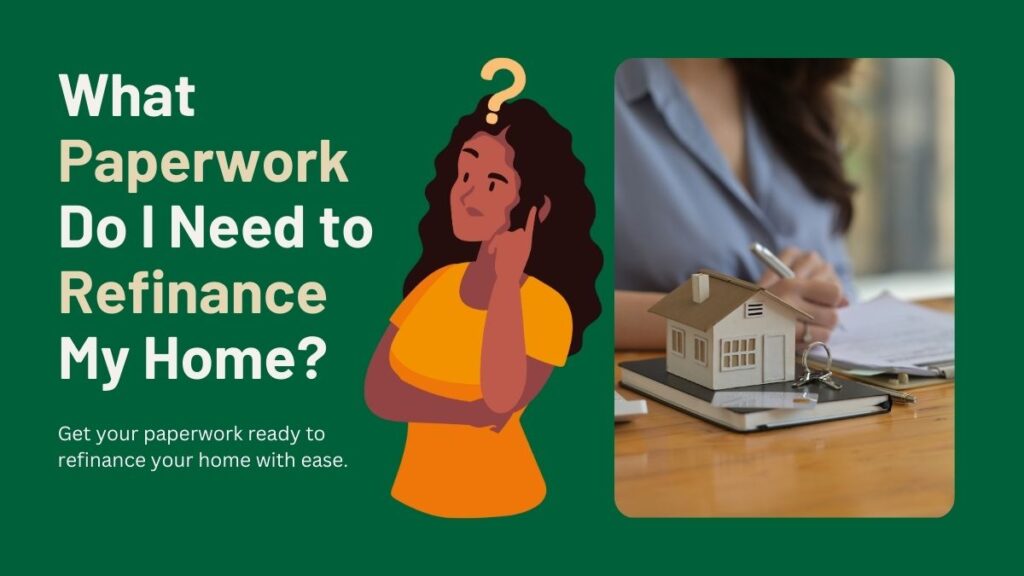Refinancing is like hitting reset on your mortgage. It can help you get a better rate, lower payments, or free up cash for home repairs or debt.
But to make it happen, you need the right paperwork. What paperwork do I need to refinance my home? Lenders check your finances and home value. Having everything ready makes the process easier and helps you get a better deal. Missing documents? That can slow things down or even stop your application.
Here’s what we’ll cover:
Thinking about Mortgage Refinance Canada? Get your paperwork sorted and get started!
What You Need to Know?
Wondering what you need to know before making a big decision? Here’s everything you should consider to make the right choice!
Key Concepts
Understanding the key concepts is crucial to making informed decisions. Here’s what you need to know to stay ahead.
Refinancing vs. New Mortgage
Refinancing vs new mortgage – understanding the difference is key to choosing the right option for your financial goals. Here’s what you need to know.
Refinancing: You swap your current mortgage for a new one, usually to get a better rate or terms.
New Mortgage: This is for when you’re buying a new home, not changing an existing mortgage.
Steps to Refinancing
Pre-Qualification: The lender quickly checks your income, debts, and credit to give you an idea of what you could borrow.
Application: You fill out forms and provide paperwork, like pay stubs and tax info.
Underwriting: The lender reviews everything to see if you’re a good fit for the loan.
Appraisal: An appraiser evaluates your home’s value to make sure it matches what you want to borrow.
Closing: You sign the final documents to finish up.
Funding: The new mortgage pays off the old one, and you’re done!
Why You Might Want to Refinance?
Why you might want to refinance. Understanding the benefits can help you make the best decision for your financial future. Here’s what you need to know.
Better Rates: If rates have dropped, refinancing can save you money.
Lower Payments: Refinancing can reduce your monthly payments by getting a better rate or stretching out the loan.
Cash-Out: If your home’s value has risen, you can borrow more than you owe and take the difference in cash.
Access Equity: You can tap into the home equity you’ve built, which might help with renovations or debt repayment.
What Lenders Look At?
What lenders look at. Knowing the key factors they consider can help you prepare and increase your chances of approval. Here’s what you need to know.
Credit Score: A higher score can get you better terms.
Income: Lenders want to see you have enough income to cover your payments.
Debt-to-Income (DTI) Ratio: The lower this is, the better—it’s the percentage of your income that goes toward debt.
Home Equity: The more equity you have, the less risky you are to lenders.
Loan-to-Value (LTV) Ratio: A lower LTV (loan size vs. home value) makes you less risky to lenders.
Why Documents Matter?
Why documents matter. Having the right paperwork in order can speed up the process and improve your chances of approval. Here’s what you need to know.
Lenders require all the right paperwork including pay stubs, tax returns, and bank statements.
Missing or incorrect documents can slow things down.
Incomplete paperwork could hurt your chances of approval.
what paperwork do i need to refinance my home
When refinancing your home in Canada, the paperwork you need can vary a bit depending on your lender and situation. Here’s a list of the typical documents you’ll need to gather:
Personal Identification
Government-Issued ID: This could be your driver’s license, passport, or any valid Canadian ID.
Proof of Legal Status: If you’re not a Canadian citizen, you might need documents like a permanent resident card, work visa, or study permit.
Income and Employment Documents
Income Verification
Recent pay stubs: Lenders usually ask for pay stubs from the last 30 days to confirm your income.
T4 slips or Notice of Assessment (NOA): These show your income over the last two years for salaried employees.
Self-Employed: You’ll need to provide your last two years of tax returns (T1 General) and business financial statements.
Additional Income
If you receive other income (e.g., child support, rental income, or pensions), you’ll need to provide proof of that as well.
Financial and Credit Documents
Bank Statements: You’ll need recent bank statements (usually from the last 3 months) showing your savings, checking, or investment accounts.
Credit Report: Lenders will check your credit, but it’s a good idea to review it yourself first for any errors or surprises.
Debt Information: You’ll need to list any current debts like credit card balances, loans, or lines of credit. Include documentation (e.g., statements) if you have them.
Property-Related Documents
Current Mortgage Statement: This shows how much you owe on your current mortgage, your interest rate, and payment history.
Homeowner’s Insurance: Lenders need to see proof that your home is insured. Make sure your insurance covers the value of the home.
Title and Deed: This proves you legally own the property.
Appraisal Report: Lenders usually require an updated appraisal or market value estimate of your home to figure out its current worth. If you’ve made any major upgrades, this could help.
Other Documents: If you’ve done home improvements, provide receipts for renovations. If your property is part of a homeowners association (HOA), you might need to show any relevant documents.
Once you have all these documents, your lender will help guide you through the rest of the process, including confirming everything and arranging for an appraisal.
Additional and Supporting Documentation
Additional and supporting documentation. Having the right extra paperwork ready can make all the difference in securing your approval. Here’s what to prepare.
Asset Documentation
RRSP (Registered Retirement Savings Plan) statements, TFSA (Tax-Free Savings Account) statements, and other retirement accounts.
Documentation of other valuable assets such as real estate, investments, or savings.
Liability Documentation
Detailed statements for debts such as credit cards, car loans, or personal loans.
Gift letters (if using gifted funds for down payment or closing costs).
Legal and Special Circumstances Documents
Credit & Financial Anomalies: Letters explaining gaps in employment, credit issues, or unusual deposits in your financial records.
Relevant Legal Documents: Divorce decrees, child support orders, bankruptcy discharge papers, or any documents related to a foreclosure, if applicable.
Refinancing Application and Closing Documents
Refinancing application and closing documents. Understanding these steps can help you navigate the process with ease and confidence. Here’s what you need to know.
Application Forms
Mortgage Application (from your lender or broker).
Loan Estimate and Closing Disclosure: In Canada, you’ll get a Mortgage Disclosure Statement with details about the loan terms, fees, and closing costs.
Closing Documents
Promissory Note: The legal agreement to pay back your new mortgage.
Mortgage Agreement: This secures the loan against your home.
Statement of Adjustments: A breakdown of any final amounts owed at closing, like taxes or utility adjustments.
Post-Closing Paperwork
Final Settlement Statement: A summary of your final costs and adjustments.
Updated Mortgage Payment Info: Details on how to make your payments (like setting up autopay or using an online portal).
Organizing and Preparing Your Paperwork
Organizing and preparing your paperwork. A little preparation goes a long way in making the process smoother and faster. Here’s how to get started.
Creating a Comprehensive Checklist
A step-by-step guide to help you collect all required documents, such as income verification, down payment proof, and credit history.
Digital vs. Hard Copy
Benefits of scanning and storing documents electronically for easy access, while still keeping hard copies for important records (e.g., mortgage documents, title information).
Tips for a Smooth Submission Process
Organize your files into clearly labeled folders, such as “Income Documents,” “Property Documents,” and “Bank Statements.”
Keep backup copies of everything and double-check that all details are accurate.
Stay in touch with your lender or mortgage broker to confirm the exact documents needed for your situation.
Common Pitfalls and How to Avoid Them
Common pitfalls and how to avoid them. Being aware of these mistakes can save you time, money, and stress. Here’s what to watch out for.
Missing or Incomplete Documents
Strategy to Verify: Make a list of everything you need to submit, like proof of income, ID, and tax returns. Double-check to make sure you have everything. If you’re missing something, ask your lender early.
Tip: Keep digital copies of your documents in one folder for easy access.
Outdated Information
Ensure Currency: Make sure your documents, like bank statements and pay stubs, are up to date (within 30-60 days). Don’t forget to check your CRA Notice of Assessment.
Tip: Mark your calendar to update documents before they expire.
Miscommunication with Lenders
Clear Communication: Stay in touch with your lender. If something changes, like your job, let them know. Ask questions if you’re unsure about anything.
Tip: Keep a record of your conversations with the lender to avoid confusion.
Procrastination
Start Early: Start gathering your documents as soon as you decide to apply. Waiting until the last minute can cause stress and delays.
Tip: Set small weekly reminders to gather your paperwork bit by bit.
Not Understanding Lender’s Requirements
Clarify Expectations: Lenders may ask for different documents depending on your situation. For example, self-employed people may need extra paperwork.
Tip: Ask your lender exactly what they need or speak to a broker for guidance.
Ignoring Small Details
Attention to Detail: Double-check for mistakes like wrong dates or missing signatures. Even small errors can cause delays.
Tip: Review your documents carefully or ask someone else to check them.
Failing to Follow Up
Stay on Track: After submitting your documents, check in with your lender to make sure everything is received. Ask when you can expect an update.
Tip: Follow up a few days after submission to stay on top of things.
Conclusion
To refinance in Canada, make sure you have all the necessary documents, like proof of income, ID, bank statements, credit reports, and your Notice of Assessment (NOA) from the CRA. Double-check everything to make sure it’s current and complete.
Final Verdict
Refinancing in Canada requires some important documents. Make sure you have proof of income, ID, bank statements, credit reports, and your Notice of Assessment (NOA) from the CRA. Check that everything is up-to-date and complete.
Key Takeaways
Start gathering your documents now! If you’re unsure, talk to a mortgage professional to help guide you through the process.
Frequently Asked Questions
What information is needed for a refinance?
You’ll need proof of income (pay stubs or tax returns), ID, bank statements, a credit report, and your Notice of Assessment (NOA) from CRA.
What documentation is typically required for a refinance transaction?
You’ll need:
Proof of income
ID
Bank statements
Credit report
Notice of Assessment (NOA) from CRA
Is it hard to get approved for a refinance?
It’s easier if you have all your documents ready. Being organized helps a lot.
How much income do I need to refinance?
It depends on the lender and the loan size. Lenders want to make sure you can afford the new payments. Check with your lender for details.


